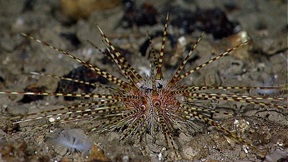As researchers succeed in tagging oceanic predators, they discover new facts about the deep sea. Many animals dive very deep, even to where light doesn’t penetrate anymore. It’s indescribable, what they unveil.

The pressure, the cold and the dark
Knowable Magazine devoted an article to the adventures of deep sea divers, by Stephanie Pain. Diving deep, hundreds or even thousands of meters, is quite common for large marine predators. They have an array of anatomical and physiological adaptations, allowing them to withstand the pressure, the cold and the dark. Like ‘insulating blubber, for instance, or blood vessels transformed into heat-exchange systems, collapsible lungs and oxygen-storing muscles, and ultra-sensitive eyes.’
Is it food they are diving for? In 2022 the Annual Review of Marine Science devoted an article to these diving predators. It’s not clear. They could seek refuge from other predators. They might want to cool an overheated body. Send messages to other individuals of their own species. And they do dive deep. Down to 2,000 or even 3,000 meters, where the light doesn’t shine anymore. The deep sea appears to be a refuge for many species, a place where they can retreat in relative safety. Typically, migrating fish and invertebrates feed at night near the surface, and retreat into the deep during daytime.
Sensors
There is a twilight zone, where many species stay. Like ‘weird and wonderful gelatinous creatures, muscular squid, the ubiquitous and highly nutritious lanternfish and the spiny-toothed bristlemouth, reckoned to be the world’s most abundant vertebrate.’ Not surprisingly, biologists find that large fish and mammals move up and down the twilight zone, together with their potential prey.
Scientists are increasingly successful in attaching sensors on predating species. Some, like white sharks and swordfish, are quite challenging. Divers cannot approach them. White sharks are lifted onto the ship; swordfish will need to get tagged in the water, as it tries to whack the tagger or bash a hole in the boat.

Diving
An unexpected insight into the life of major fish of prey resulted from researching the Chilean devil’s fish (Mobula tarapacana); a giant mysterious fish often found sunbathing around the Acores. It was not until some of them were equipped with an emitter that their real nature appeared. They can swim up to thousands of kilometres, and dive down to 1,000 metres. In doing so, they often stay at one depth for some time, probably because that’s where they find their prey.
Sharks show similar behaviour. They make good use of gyres around the North Atlantic gulf stream. These trap relatively warm water and may therefore be places where fish assemble – prey, in other words. These gyres can attain depths of hundreds of meters. Sharks often stay at such places.
Emitters
Researchers also fitted a species of dolphin (Globicephala macrorhynchus) with an emitter. These fish emit clicks as they hunt, in order to localize their prey, and more as they approach it. Unfortunately, they hunt at depths – down to 1,000 meters – where light doesn’t penetrate. What would they catch? Maybe large squids?
But then, short movies shot by female Californian fur seals might help. These animals aren’t shy or aggressive to people – at least if they are not with kids. Cameras found that the fur seals dive for as much as 20 hours per day, mostly to 400 to 600 meters, a depth at which many lanternfish hide. The Japanese researcher Yasuhiko Naito developed a light source that is only lit as the seal opens up its jaws. From the fuzzy images that Naito and colleagues developed, they inferred that the seals were looking for preys like lantern fish, hake and squid.
Avoid predators
There may be a good reason why so many fish dive deep into the ocean: escape from predators. Tuna fish for instance can sometimes dive very deep – 1,000 meters or more – probably to escape from a predator. One unfortunate fish, equipped with a sensor, didn’t escape its fate. Researchers saw that at a depth of 326 meters, everything became dark all of a sudden, and temperature went up; probably, the animal had been swallowed by a predator.
Seals as well dive deep in order to escape from animals of prey. Over ten years ago, marine biologist Selene Fregosi of Oregon State University mounted little speakers to seals. These could emit the sound of animals of prey. Invariably, this resulted in the test animals diving away, into the depth. Later, researchers proved that these animals also rest at considerable depths.
Into the deep
Stephanie Pain asks herself: are there any more reasons to dive deep? Yes, one of them appears to be navigation. At considerable depth, maybe the signals of the Earth’s magnetic field are stronger. Bluefin tuna fish probably dive deep in order to cool down – and even to give birth. And possibly, the deep sea is a good location for communication. Soundwaves will travel farther in the deep.
But there is much to be discovered. Researchers would like to connect more precise instruments to fish and sea mammals. Like depth meters. Or smart cameras – mini instruments that could even transfer good images where there is very little light. There is still a lot to be done!
Interesting? Then also read:
Marine biotechnology: major opportunities, many obstacles
Life is still a black box
Directed evolution: a Nobel prize winning innovation
